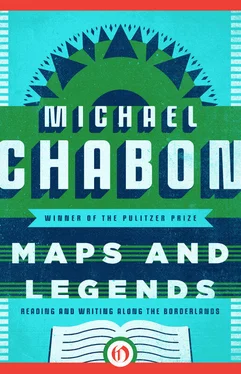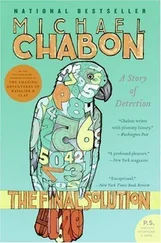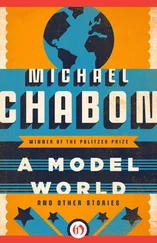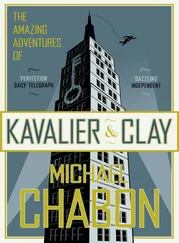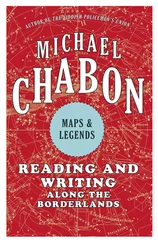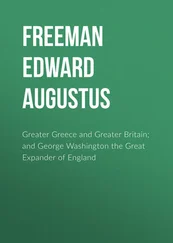Michael Chabon - Maps and Legends - Reading and Writing Along the Borderlands
Здесь есть возможность читать онлайн «Michael Chabon - Maps and Legends - Reading and Writing Along the Borderlands» — ознакомительный отрывок электронной книги совершенно бесплатно, а после прочтения отрывка купить полную версию. В некоторых случаях можно слушать аудио, скачать через торрент в формате fb2 и присутствует краткое содержание. Год выпуска: 2011, Издательство: Open Road Media, Жанр: Критика, Публицистика, на английском языке. Описание произведения, (предисловие) а так же отзывы посетителей доступны на портале библиотеки ЛибКат.
- Название:Maps and Legends: Reading and Writing Along the Borderlands
- Автор:
- Издательство:Open Road Media
- Жанр:
- Год:2011
- ISBN:нет данных
- Рейтинг книги:5 / 5. Голосов: 1
-
Избранное:Добавить в избранное
- Отзывы:
-
Ваша оценка:
- 100
- 1
- 2
- 3
- 4
- 5
Maps and Legends: Reading and Writing Along the Borderlands: краткое содержание, описание и аннотация
Предлагаем к чтению аннотацию, описание, краткое содержание или предисловие (зависит от того, что написал сам автор книги «Maps and Legends: Reading and Writing Along the Borderlands»). Если вы не нашли необходимую информацию о книге — напишите в комментариях, мы постараемся отыскать её.
Maps and Legends: Reading and Writing Along the Borderlands — читать онлайн ознакомительный отрывок
Ниже представлен текст книги, разбитый по страницам. Система сохранения места последней прочитанной страницы, позволяет с удобством читать онлайн бесплатно книгу «Maps and Legends: Reading and Writing Along the Borderlands», без необходимости каждый раз заново искать на чём Вы остановились. Поставьте закладку, и сможете в любой момент перейти на страницу, на которой закончили чтение.
Интервал:
Закладка:
I was beginning to learn the bitter truth about golems. A golem, like a lie, is the expression of a wish: a wish for peace and security; a wish for strength and control; a wish to know, in a tiny, human way, a thousandth of a millionth of the joy and power of the Greater Creation. And nothing I have learned since has ever been able to dissuade me that on that April night a golem, charged with all the wishes, dark and light, of a suffering people, was created and set loose in the world.
Soon after his world was set on fire, my uncle Jack fell while chasing after a young black neighborhood kid who had, or so he imagined, called him “Hymie.” He broke his hip. He went into a rapid decline after that, and was dead before the following autumn. It was around that time that I managed to get down into the basement again. This part may be the embroidery of a guilty recollection, but I remember it as being on the actual day of Jack’s funeral, when we all went back to the house to start the weeklong period of shivah. As I had suspected it would be, the giant doll with the dead, fearful eyes was gone. I got down on my hands and knees and looked around, and there, under the now barren workbench, lay the toe.
After a while my father came downstairs looking for me. Since he didn’t seem to be angry at finding me in such close proximity to dangerous tools and chemicals, not to mention trespassing into forbidden zones of mystic knowledge, I told him the whole story. He laughed, and reassured me that I was not in any way responsible for my uncle’s death, explaining that Uncle Jack had had his little eccentricities when it came to religion. But I could see that my father was not taking me seriously. So I showed him the toe.
“Well,” he said, studying it, taking me a little more seriously now, it seemed to me. “If you had brought it to life, that wouldn’t be too surprising, I guess. You know, Michael, we’re descended on my father’s side from Rabbi Judah ben Loew.”
It was then and there, and not from any book on fantastic cinema, that I first learned about golems and in particular the Golem of Prague. My father explained to me that it was the great Rabbi Judah of Prague who, sometime in the sixteenth century, created the best-known of all golems to do his bidding around the synagogue, sweeping up the dooryard and readying the sanctuary for the Sabbath, and to help protect the Jews of Prague’s ghetto against those who sought to harm them. This golem, like a lie, grew to a tremendous size, and in its vengeful might came in time to threaten the security of those it had been made to keep safe. Rabbi Judah lost control of it, and eventually he was obliged to destroy the life he had talked into being, in order to keep it from destroying everything else. And it was from this great wonder-working rabbi, through a grandson who left Prague and traveled across the Austrian Empire to settle in Lodz, that we were descended. Or so my father said. He had told me such things before, about other famous Jews from history, and he would continue, as I grew older, to periodically reveal new and ever more startling connections.
A writer of science fiction named Philip José Farmer once devised the amusing or tedious conceit of tracing the lineage of Lord Greystoke, better known as Tarzan of the Apes. Mr. Farmer postulated that an ancestor of the future lord of the jungle was among the passengers of two coaches that were passing Wold Newton, England, in 1795, just as a radioactive meteor fell from outer space into a meadow on the outskirts of the village. The radiation from the space rock, and the genetic mutation it caused, Mr. Farmer posited, affected all the descendants of those passengers, among them the eventual John Clayton, Lord Greystoke — Tarzan. Mr. Farmer then extended his conceit by claiming that not only Tarzan but all the great heroes and villains of popular nineteenth- and twentieth-century literature — the Scarlet Pimpernel, Sherlock Holmes and Professor Moriarty, Doc Savage, Phileas Fogg, Fu Manchu, Sam Spade, James Bond — were descended from the people riding in that pair of coaches, a superhuman lineage of siblings and cousins descended from that common ancestor and that catastrophic event.
When, as a boy of nine or ten, I encountered Mr. Farmer’s hypothesis in his amusing mock biography of Tarzan, it came as no surprise to me at all. My father had already articulated, in considerable detail, a similar startling theory of our own lineage.
Over the years my father has informed me — generally with no warning and without offering any explanation for the information’s having gone unmentioned until that moment — that we Chabons are connected, distantly perhaps but with a kind of telling intimacy, to the following people: the great tragedienne Rachel, the humorist Art Buchwald, the vicious murderer Lepke Buchalter, Rabbi Eliyahu, known as the Gaon or Genius of Vilna, the aforementioned Rabbi Judah ben Bezalel ben Loew, Harry Houdini, the first-class spy and third-rate baseball player Moe Berg, and, most gloriously of all, Napoleon Bonaparte, through his nephew Napoleon III, who — or so my father claims — fathered an illegitimate child, my ancestor, of the above-mentioned French actress, Rachel.
I won’t bother with the question of whether my father is telling the truth, or believes he is telling the truth, when he says such things. Nor is it germane to my point to ask if I believe him. After all, what he says could be true; if plausibility is good enough for me as a reader, and good enough for you as listeners, it’s good enough for me as a son. The importance to me, now and as a child, of my father’s stories is and was 1) their peculiar, detailed beauty, from the quirkiness of the famous personalities they involved to the complicated ways in which my father attempted to map out our relation to these people, and 2) the sense of incredible connectedness I derived, as a kid, from his stories. Listening to my father describe the deeds, crimes, and achievements of our famous cousins, scattered as they were across continents and eras, gave me an almost vertiginous sense of simultaneity, of our family’s and my own small self’s existing in all times, at all places.
When I was ten years old — shortly after reading Philip José Farmer’s biography of Tarzan, with its genealogy of heroes and criminals almost as fantastic as my own — I produced my first sustained work of fiction. This was a short story, about twelve pages in length, entitled “The Revenge of Captain Nemo.” It recounted a meeting between Verne’s Captain Nemo and Doyle’s Sherlock Holmes (first cousins, according to Farmer). I won’t make any claims as to its merits, but two great things happened to me in the course of writing it. One was that I consciously adopted, for the first time, a literary style: Sir Arthur Conan Doyle’s, or rather that of the good Dr. John Watson. I think I had always been sensitive, before this, to variations in writers’ diction and to the mood and tone of a paragraph. I was alert to the difference in vocabulary and idiom one found in British storybooks, could tell when language was trying to sound antiquated, jocular, or hard-boiled. I could hear the difference between words of Latin origin and those that came from Anglo-Saxon. I knew how Doyle’s writing sounded. I could hear the tune of it in my head. Now I just had to sit down and play.
Getting the style down — that was more than half the fun for me. I used words like “postulated” and “retribution.” I wrote “had the odor of” instead of “smelled.” I went on about railway schedules, the harbor at Portsmouth, the fog. I referred to the infamous Moriarty as “the Napoleon of Crime,” thus linking him, in my imagination, to my own family tree. When I finished it, “The Revenge of Captain Nemo” went over pretty well. I had the satisfaction of being praised by my parents and other adults and of having actually completed something that struck me as admirably substantial, even huge. The work of typing it alone had nearly killed me. But more precious to me than praise or completion was the intense pleasure I had derived from attempting to impersonate Sir Arthur Conan Doyle, from putting on his accent, following his verbal trail: It was the pleasure that a liar takes in his lie as it enters the world wearing the accent and raiment of the truth, sounding so right and plausible that — if he is any kind of liar at all — he begins, himself, to believe it. It was the pleasure that a maker of golems takes as the force of his words, the rhythm and accuracy of his alphabetical spells, blow life into the cold clay nostrils, and the great stony hand unclenches and reaches for his own. At some point in the exercise the power of Doyle’s diction resounding in my ear carried me away. I felt intimately connected to him, as though it was not I inhabiting his literary skin but, somehow, the other way around. It was like something out of a ghost story — a child sitting down at a haunted piano and feeling a spectral hand guide his own over the keys.
Читать дальшеИнтервал:
Закладка:
Похожие книги на «Maps and Legends: Reading and Writing Along the Borderlands»
Представляем Вашему вниманию похожие книги на «Maps and Legends: Reading and Writing Along the Borderlands» списком для выбора. Мы отобрали схожую по названию и смыслу литературу в надежде предоставить читателям больше вариантов отыскать новые, интересные, ещё непрочитанные произведения.
Обсуждение, отзывы о книге «Maps and Legends: Reading and Writing Along the Borderlands» и просто собственные мнения читателей. Оставьте ваши комментарии, напишите, что Вы думаете о произведении, его смысле или главных героях. Укажите что конкретно понравилось, а что нет, и почему Вы так считаете.
